Table of contents
- Chassis special: tire wear Inferring weaknesses in the chassis from the wear pattern of the tires
- Tips for the racetrack
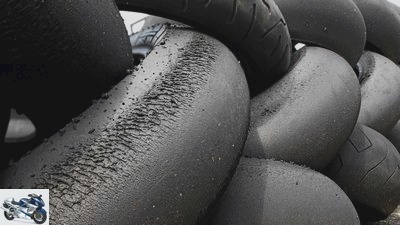
archive
accesories
landing gear & Spring elements
Chassis special: Part 10 – Tire wear
Chassis special: tire wear
Inferring weaknesses in the chassis from the wear pattern of the tires
Content of
Show me your tires and I’ll tell you the problem: The wear pattern of pelts also allows conclusions to be drawn about weaknesses in the chassis. But the causes of unusual abrasion can be complex.
06.10.2012
In the paddock of a racing training session. A couple of buddies examine the rear skin of one of their bikes. Although only a few turns old, the rubber on the flanks is pretty much worked up. “The suspension setup is completely wrong,” says one wise guy. “Total nonsense,” says another, “the mixture is too soft for the rough asphalt.” “Oh, the mixture doesn’t suit the temperatures,” claims a third party. Who is right? In principle, each of the reasons mentioned stresses the tires excessively, which means that they wear out quickly and show an abnormal wear pattern. There are also other reasons for this, it is the individual case that counts. For precise analyzes, experts therefore basically need information about conditions such as air and asphalt temperature, the nature of the asphalt (rough, fine), tire mixture and air pressure. Lap times, bike, riding style and rim width also play a role. It is important to know whether or not tire warmers have been used. The more numerous and more precise the information, the clearer the cause of the corked wear pattern.
We discussed the most typical pictures with specialists from tire manufacturers. Although we could not provide them with any information about the circumstances that led to the wear pattern, the professionals narrowed down the causes. The analysis is in the individual boxes, multiple statements are possible. In a separate box we give tips for the longest possible tire life on the slopes. An important piece of advice in advance: When buying tires, always ask the manufacturer or other experts (racing service, well-known dealers) about the right mixture, the recommended air pressure of your favorite rubber for the respective route and the expected temperatures. On this subject, we also recommend the overview of all current race track suitable rubbers from well-known manufacturers (PS 4/2012). The list contains, among other things, information on different mixtures and correct air pressures.
Extreme abrasion patterns usually only occur on the racetrack, because the slippers are subject to much more stress there than on the country road. At this point some information for the very wild faction: If you put the rubbers in public areas like on the race, then you deserve 1) respect, you should 2) not get caught, 3) do not lie on your mouth and 4 ) hire a professional racing team!
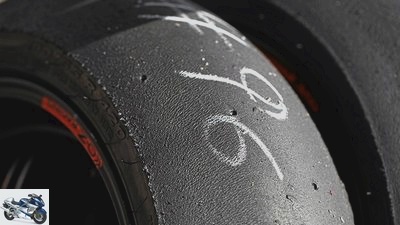
archive
Tip, top.
Everything is perfect here. Both photos show fine, even rubber abrasion without cracks or other abnormalities. If pelts look like this, you can continue shooting without any worries.
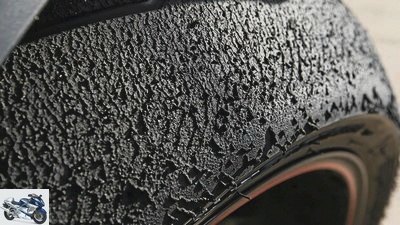
archive
pure stress.
This tire shows its high mechanical load. It was probably used very hard for a very long time and was very hot. This resulted in the formation of large, cylindrical rubber beads. The rear of the car “rolls” on them even at moderate lean angles and without accelerating towards the edge of the bend. As soon as the driver turns in, he feels that the sidegrip is decreasing. Time for a tire change. The abrasion pattern shows no further special features.
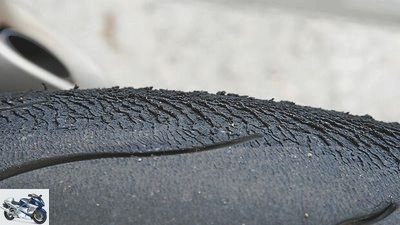
archive
Scale pattern.
An abrasion of the nasty kind. Due to the strong, scale-like cracks on the flank, the bike only slides around and barely builds up grip. “Either the asphalt was too rough for the rubber compound or the asphalt temperatures too low,” analyzes Karlheinz Diepold from Pirelli / Metzeler. “The tire pattern is typical for it. Before the tire had reached the correct working temperature, it was destroyed, ”says the customer service manager. “A similar picture arises if the shock absorber is set much too hard, the tire then has too much slip.” Peter Baumgartner from Bridgestone agrees: “If the spring is too hard or very pretensioned, the tire must take over the work of the shock absorber. As a result, it tears open over time. The same thing happens if the air pressure is too high ”. The tire technician from MotoGP brings another possible cause into play: “If the balance of the motorcycle is too front-heavy, the tire builds up too little grip in the maximum lean angle, which affects the side grip.”

archive
Uneven wear.
The experts attribute the uneven wear pattern with strong and less strong depressions primarily to an incorrect shock absorber setup. But that’s where the similarities end. Because one suspects the cause in a too hard, the other in a too soft damping setting. Both explanations sound plausible. If the compression damping is too tight (it controls the compression), the monoshock does not absorb the bumps of the road, passes them on to the tire and the rear wheel tends to jump. It takes off briefly, slips through and comes back on the ground. In the long run this kills the tire as you can see in the photo. If the damping is too soft, the tail pumps wildly up and down. This also causes different loads on the tire and thus creates an uneven wear pattern. In addition, the skin becomes very hot. “It is possible that the driver was too heavy for the spring used,” suspects a specialist. The solution: Read the special chassis parts one and three, tune the monoshock and accelerate in a relaxed manner.
If the setup of the shock absorber fits and the tire still shows this wear pattern, the rubber compound is very likely too soft. If the pilot maintains a driving style in which he drives relatively slowly into the corners and brutally accelerates out of the corners, this also stresses the tire. In general, the opposite driving style – fast in, slow out – is gentler on the rear skin.
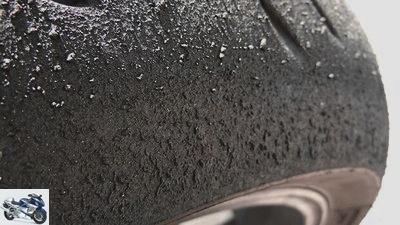
archive
Coarse abrasion.
Despite the somewhat coarser abrasion, the wear pattern is very neat. A certain image is often characteristic of a manufacturer. Like here at Michelin, whose sport skins have often noticed a somewhat rough abrasion pattern. However, it has no negative impact on performance.
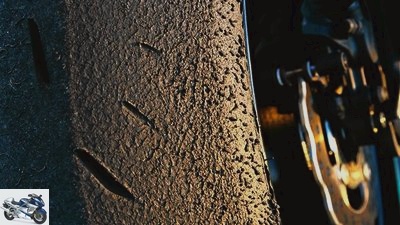
archive
Violent accelerations.
Basically a smooth tire appearance. The strong abrasion between the center and the edge of the tread indicates strong acceleration in a medium lean angle. “Since the tire shows fewer treads on the flank than further inside, it was probably driven on a track with fast corners and little lean angle like the Red Bull Ring in Austria,” suspects Diepold. The wear pattern is okay. The Bridgestone man also gives the green light: “The transition from the outer tire wall to the traction area looks great,” he enthuses. “But you can see that the tire was heavily stressed. Maybe the mixture was a tad too soft or the driver was too heavy. The tire is probably starting to lubricate slowly. But the bottom line is a great wear pattern. “
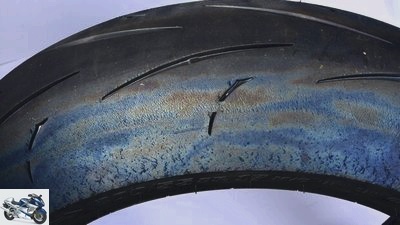
archive
Blue discoloration.
Predominantly shimmering bluish, sometimes with a dash of brown or green: According to Pirelli, the discoloration comes from escaping anti-aging agents and occurs under high mechanical stress and the resulting heat. Pirelli calls this phenomenon “blueing”. Bridgestone calls the effect “oiling out” and attributes it to an excessively high oil content in the mixture. Either way: The discoloration has no effect on the driving characteristics, even brightly shimmering pelts allow maximum attack!

archive
Tread center.
Tread center.
This image indicates strong acceleration and / or high-speed driving (straight ahead). Both create slip, which can be clearly seen in the profile. Our experts also recognize a high braking torque acting on the tire. Caused by a missing slipper clutch or a front that dips too far when anchored heavily. The undulating abrasion between the tread grooves, on the other hand, looks great – like slightly rippled water on a lake, which speaks for perfect wear.
Tips for the racetrack

jkuenstle.de
Tips for the racetrack.
1) Choose tires that match the lap time. A professional slick has no place in amateur hands – risk of cooling off!
2) Tire compound must match the temperature and the nature of the asphalt. Ask manufacturers or other experts.
3) Always preheat pelts with tire warmers – at least 45, better 60 minutes before shooting. This protects the rubber, as tires are often stressed too quickly when they warm up. Use electric blankets between turns. After the last run, put on the warmers without plugging them in – tires love gentle cooling.
4) Use recommended air pressure. Most manufacturers indicate it as “hot air pressure” for racing skins. Check the air pressure only when the tires are completely preheated and correct if necessary.
5) Use fresh silt if possible. Modern tires do not lose any of their properties when stored correctly (dark, cool) and even fast hobby racers do not notice any difference between dewy and slightly older rubbers. But ancient tires have no place on the slopes. Pure racing skins offer maximum performance for up to nine months.
6) Adjust the landing gear correctly. Only with a perfect setup can tires and bikes develop their full potential.
Related articles
-
PS reader question on motorcycle technology – tire wear on the racetrack
jkuenstle.de 5 pictures markus-jahn.com 1/5 “What is the reason for the flaky, frayed way in which racing tires are destroyed??”, asks us reader Holger…
-
Chassis special: Part 2 – fork damping
fact accesories landing gear & Spring elements Chassis special: Part 2 – fork damping Chassis special: fork damping Front wheel damping – the dream setup…
-
Chassis special: Part 6 – Troubleshooting the front of the vehicle
archive accesories landing gear & Spring elements Chassis special: Part 6 – Troubleshooting the front of the vehicle Suspension special: troubleshooting…
-
Restoration of the BMW R 80 G-S, part 5 chassis and brakes
Cook 19th pictures Cook 1/19 Cook 2/19 On the left the new, on the right the plate-shaped, warped coupling base plate. Cook 3/19 Clutch removal, act…
-
Chassis Special: Part 5 – Troubleshooting and Basics
Jahn accesories landing gear & Spring elements Suspension special: Part 5 – Troubleshooting and basics Suspension special: troubleshooting and basics…
-
Suspension special: Part 8 – fork tuning
Jahn accesories landing gear & Spring elements Suspension special: Part 8 – fork tuning Suspension special: fork tuning What are the real benefits of…
-
Suspension special: Part 3 – Strut damping
triumph accesories landing gear & Spring elements Suspension special: Part 3 – Strut damping Suspension special: shock absorber The right set-up for the…
-
Test winner tire test part 2 – Enduro tires (MOTORRAD 13-2015)
mps studio accesories tire Test winner tire test part 2 – Enduro tires (MOTORRAD 13/2015) Test winner tire test part 2 – Enduro tires (MOTORRAD 13/2015)…
-
What is the best motorcycle sports tire of 2015?
mps photo studio 11 pictures mps photo studio 1/11 The RS 10 is a very decent skin with many strengths and without significant weaknesses. Accordingly,…
-
Tire age, inflation pressure, balancing
Marcus Jahn accesories tire Tire age, inflation pressure, balancing Tire age, tire pressure, tire balancing Motorcycle tires and their problems Even when…